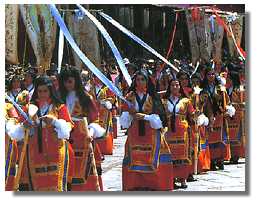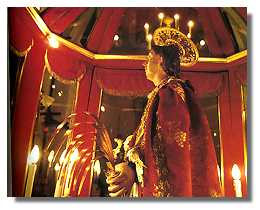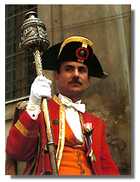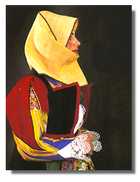
It is useless to search for only historical or religious sentiment in the festival
of Saint Efisio, the most important holiday in Sardinia. Every May 1st, legend and
history, devotion and folklore meld.
History tells us that Efisio was born in the second half of the 3rd century A.D. at
Elia, near Antioch in Asia Minor. Enlisted in Diocletian's army, the young pagan
warrior was sent to combat against the Christians in Calabria. There, he had a revelation
when the sign of the cross appeared impressed upon the palm of his right hand. After
his conversion, he was sent to Sardinia to defend Roman supremacy. Although he continued
to combat against the tribes hostile to Diocletian, he was nonetheless suspected
of treason. He was imprisoned, tortured, and beheaded on January 15, 303 A.D.

On the
block erected at Nora, the condemned man offered his life for the salvation of Cagliari.
An account of the martyr's suffering, written in Latin, has come to us from a religious named Marco, who was supposedly an eye-witness to the execution. Devotion to the
saint transcends any doubts that might exist concerning the historical truth of the
events. In 430 A.D., a church was built above the underground prison in Stampace
where the saint is believed to have been imprisoned. In the Byzantine era a shrine was erected
on the site where Efisio was presumably executed.
The cult of Saint Efisio, who is also venerated in Pisa, grew in popularity in Cagliari
and the rest of Sardinia. Every year, presumably on the anniversary of his death,
a feast day was celebrated in his honor. It was not until 1652, when Cagliari was
decimated by the plague, that the event acquired the solemn quality of devotion that still
characterizes it today. Terrified by the prospect of an uncontrollable epidemic,
the city council bound the city to the promise of a yearly rite in gratitude for
the saint's intercession in ending the terrible disease. The month of May, symbolizing nature's
rebirth, was chosen to celebrate the festival, which has been held without fail since
then.
|









